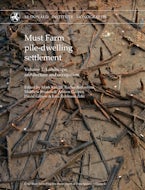It is just over forty years since the start of the excavations of the Ascott-under-Wychwood long barrow (1965-69) under the direction of Don Benson. The excavations belonged to the latter part of a great period of barrow digging in southern Britain, which was ending just as, by striking contrast, intensified investigation and fieldwork at causewayed enclosures were beginning. Although a long gap has passed since the excavations took place, they have nonetheless produced a rich and important set of results, and the analysis has been enhanced by more recent techniques. The site now joins Burn Ground and Hazleton North as one of only three Cotswold long barrows or cairns to have been more or less fully excavated. The barrow had been built in two main stages, in a series of bays defined by lines of stakes and stone, and filled mainly with earth and turf, with some stone; it was enclosed or faced by stone walling, the outermost being of very fine quality. The barrow contained two opposed pairs of stone cists, each with a short passage from the long sides of the monument. The cists and passages contained the remains of some 21 people (of all ages and both sexes), probably deposited in a variety of forms from fleshed inhumations to incomplete secondary remains and cremations. The barrow was built in the 38th century cal BC and was probably one of the earliest such constructions in the region. It was probably in use for only three to five generations, lasting into the 37th century cal BC. Occupation features from the early fourth millennium cal BC included small pits, hearths and two small timber post structures, and there were finds of pottery, flint, axe fragments, stone querns and animal bone. People used cattle, sheep and pigs, and there is a range of wild species, especially in the midden. The authors of this report not only document the finds and research, but also address wider questions of how the early Neolithic inhabitants viewed their society through the barrow, and how the development of the site reflected memory and interaction with a changing world.
The Excavations of 1965-1969 (Don Benson with a contribution by Fiona Rue)
The Pre-Barrow Contexts (Lesley McFadyen, Don Benson and Alasdair Whittle)
The Environmental Setting (John G. Evans, Susan Limbrey and Richard Macphail)
The Long Barrow (Lesley McFadyen, Don Benson and Alasdair Whittle)
The Layout, Composition and Sequence of the Human Body Deposits (Alasdair Whittle, Dawn Galer and Don Benson)
The Human Remains (Dawn Galer with a contribution by Christopher Knusel)
Interpreting Chronology: The Radiocarbon Dating Programme (Alex Bayliss, Don Benson, Christopher Bronk Ramsey, Dawn Galer, Lesley McFadyen, Johannes van der Plicht and Alasdair Whittle)
The Animal Bones (Jacqui Mulville and Caroline Grigson)
Carbon and Nitrogen Stable Isotope Compositions of Animal and Human Bone (Robert E. M. Hedges, Rhiannon E. Stevens and Jessica A. Pearson)
The Early Neolithic Pottery and Fired Clay (Alistair Barclay and Humphrey Case, with Mark Copley, Chris Doherty, Richard Evershed, Kevin Nimmo and Alasdair Whittle)
Organic Residue Analysis (Mark S. Copley and Richard P. Evershed)
The Flint (Kate Cramp, with Humphrey Case and Kevin Nimmo)
The Worked Stone (Fiona Roe)
Post-Neolithic Finds ( Edward Biddulph, Peter Guest and William Manning)
Place and Time: Building and Rememberance (Alasdair Whittle, Alistair Barclay, Lesley McFadyen, Don Benson and Dawn Galer)











